|
|
|
FELINE MEDICAL CURIOSITIES: FUR AND SKIN
Note: Contrary to suggestions on some bulletin boards, the images here are not photoshop. With the exception of those labelled as artist's impressions these are photos of medical conditions. Offsite links to images on these pages is not supported - bandwidth costs money!
STICKY FUR ANOMALY
Jocelyne Durrenberger of the Metrowest Animal Awareness Society reported the case of Sticky-Furred cats in October 2006. Several cats and kittens were removed from a cat hoarder's house. There was evidence of inbreeding. In three different litters, 4 kittens had sticky fur. At first it was belived to be a saliva problem of the mother, but no matter how the kittens were bathed, the problem did not resolve. They also had sticky eyes and were diagnosed with keratitis, possibly herpetic. They get twice daily drops and lysine supplements. All are FeLV/FIV negative and their basic chemistry (bloodwork) was normal. It seems to have a genetic component, but the costs involved prevent proper study by a geneticist are prohibitive for the rescue shelter and would be unlikely to change their treatment.
|
|
|
Two cats, Lucy and Hilary are shown here. It is causing problems with having them adopted, because they are unattractive with the continual staining near their eyes (black/brown crusting), and their fur has an unsettling feel. The stickiness does not feel moist, it feels tacky and is uniform across the coat. When they were kittens it was much worse. One vet believes it may be a malfunction of the oil glands.
HAIRLESS AND CURLY-HAIRED CATS
Several mutations affect the fur. The best known are the various Rex strains, various hairless strains (including the Sphynx) and the American Wirehair. The Hawaiian Hairless not only lacks fur, it lacks hair follicles. These are detailed at Fur Types.
|
|
|
|
|
Tope Left: Extinct Mexican Hairless Cats |
ICHTHYOSIS
These two kittens were in a litter born to a 6 year old farm cat and reported by Jess Sathoff-Haukoos, Jackson, Minnesota in June 2021. They were born with hard cracked skin, were stiff, cold and survived only a short time. Their condition is consistent with Harlequin-type Ichthyosis where the skin is covered with plates of thick skin that crack and split apart. These distort facial features, giving the distinctive open-mouth where the lips are pulled back. The conditions is described in humans, and the hard plates of skin can restrict movement, breathing and eating and cause overheating because the skin cannot lose heat effectively. Cracks in the plates are susceptible to infection. It is caused by a mutations in the ABCA12 gene which helps regulate protein synthesis and lipids (fatty molecules) in the skin layer. It is an autosomal (non-sex linked) recessive condition, which means the affected kittens had 2 copies of the faulty gene. This means the mother is a carrier and had mated with another carrier, probably her own father, brother or son (not uncommon in farm colonies). The motherís siblings and offspring are all at risk of being carriers.
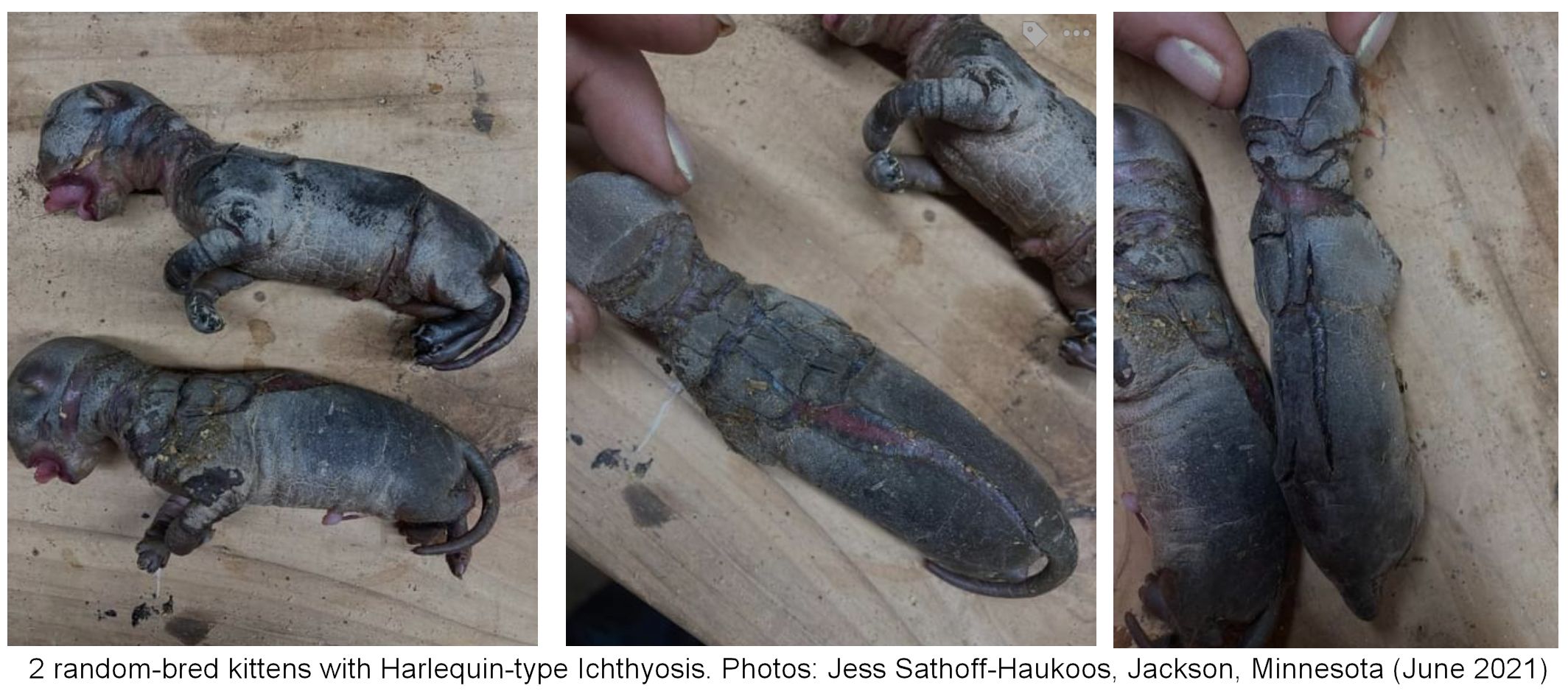
HYPERTRICHOSIS
Hypertrichosis means excessive hair growth and while you might think a cat with this condition would look like a Persian, they actually look like this cat whose pictures went viral on the internet during early 2015. Nine month old Atchoum ("Sneezy"), owned by Nathalie in Quebec, Canada, has hypertrichosis and a large fan-following as a result of his Schnauzer-like looks. Unlike the normal longhair genes, hypertrichosis causes all of his fur to grow excessively, whereas longhair cats have shorter fur on their faces, legs, ears, muzzle etc. By contrast, a cat with hypertrichosis has a dishevelled look and excessive fur all over, including the face and paws. It can stem from hormonal issues or a genetic mutation and human cases show that it can either affect the whole body or just specific areas. It can be present at birth or develop later in life, typically when there are hormonal changes. Thus far, no-one has tried to develop this as a breed trait.
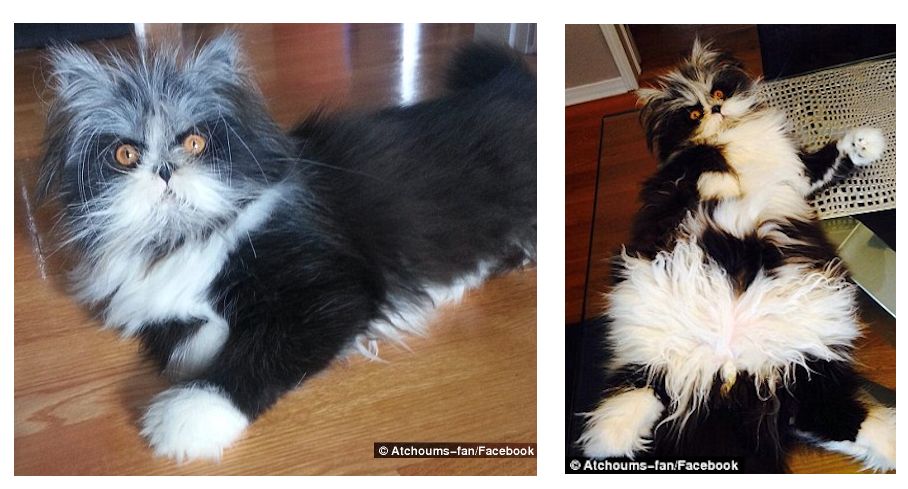
Moony, also of Quebec, Canada, also has a hormonal disorder that causes excessive hair growth, giving her wiry whiskers and extra-large claws. Her owner, Luc Michaud, found her abandoned as a kitten in a cat carrier outside his apartment block on a freezing night in 2014. He was not planning on adopting a cat, but he fell in love with yellow-eyed kitten. Moony needs a lot of care to stop her long hairs getting in her eyes and her nose and she needs eye drops every day. She has to have her fur cut as her condition means that her hair growth is excessive and out of control. Sometimes she sports a little pink dye in her long ear tufts.
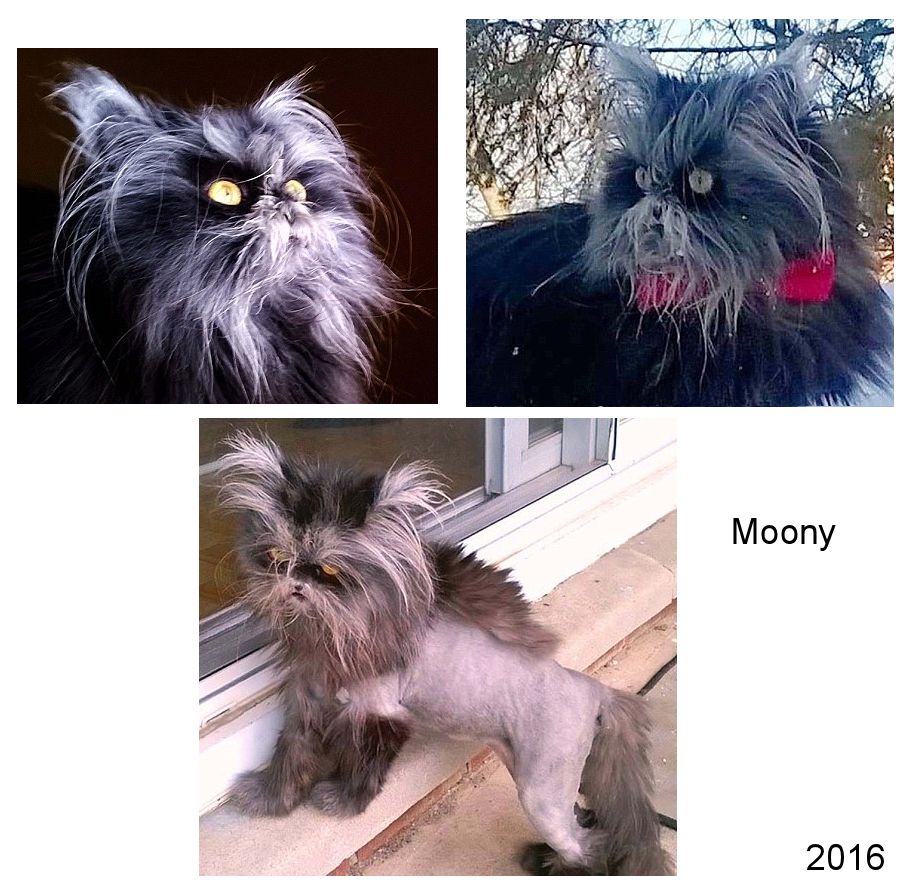
Because both cats come from Quebec, they are quite likely to be related.
EHLER-DANLOS SYNDROME
In June 2019, the British press reported the case of Toby, from Gloucestershire, who had Ehlers-Danlos syndrome (defective collagen). This gave Toby a permanently sad expression due to sagging skin on his face. His skin was also easily damaged due to its lack of connective tissue. Luckily he didnít seem to have any of the other health problems that can occur with Ehlers-Danlos syndrome. Toby, and another cat Quinton, were rescued from a hoarderís house by RSPCA, and he was apparently nervous and traumatised by his early experiences, but became a playful affectionate cat in his new home.
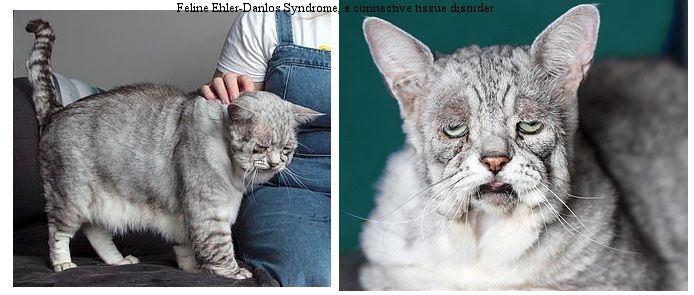
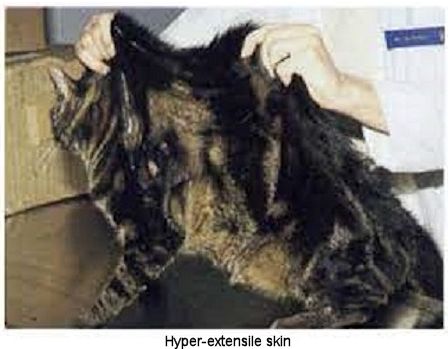
WINGED CATS
Feline Cutaneous Asthenia, where the fur forms wing-like folds or is unusually elastic, is detailed at Winged Cats.

THE BULGARIAN GREEN CAT
In 2014, a stray cat (or at least it seems to be a stray) at a Bulgarian seaside town of Varna made headlines due to his green colour. At first, outraged locals believed that the green cat had been attacked and painted or dyed. They set up a Facebook group called "Punishment to the the perpetrator of this criminal act". It later transpired that the cat habitually slept on a pile of synthetic green paint left in a garage. over a period of time, the paint has discoloured the entire cat. Each time s/he sleep on his pile of paint, the colour intensifies. Not everyone is satisfied with this explanation as the colour is evenly distributed, suggesting a dye job. Every time the cat grooms, it is ingesting some paint or dye, which won't be doing it any good. Instead of photographing it, locals really need to find it a sleeping place away from green paint. Some time later, the cat had reverted to its normal colour due to getting wet, but was likely to get a green tint as soon as it started sleeping on the paint again.
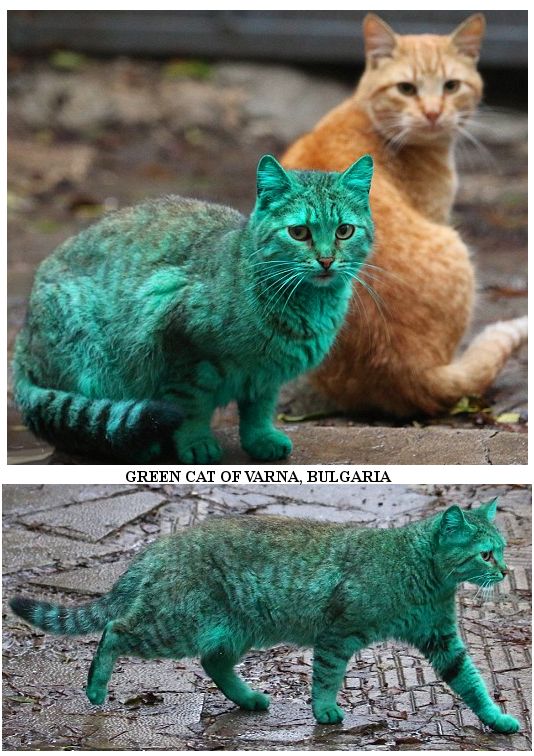
THE GREEN KITTEN
|
|
The "green kitten" was caused by water pollution not a mutation; her colour faded when she was no longer exposed to the polluted water. Cat lovers hoping for a new colour which could be passed on by breeding were sadly disappointed - the picture on the right is an artist's impression only. |
|
In 1995, a green kitten "Miss Greeny" was born in north-west Denmark. Mrs Pia Bischoff found the green kitten near a hay loft. Its fur and even its claws were green and the discovery created a sensation among zoological experts in the country and geneticists hoping the colour was due to a genetic mutation. Mrs Bischoff, whose 5 year old daughter adopted the kitten, said she had tried to wash out the colour without success. A vet who examined the cat said it was perfectly healthy but confirmed that it had a copper patina, apparently present since birth, from the tip of its fur to the hair follicles. Samples of Miss Greeny's fur was sent to study at Rigshospitalet; no chenmicals were found to be present (such as hair dye), but the hair was green all the way down in the hair follicles so the colour had been produced as the hair grew. There was a similar human case in a southern Swedish town in which the hair of several blonde women turned green due to the amount of copper present in corroded water pipes. It was possible the kitten was excreting excess copper through the skin although others believed it was due to a metabolic defect.
The green colouration did in fact turn out to be due to the high copper content in water in the area - this had caused a verdigris effect on the kitten's grey fur. Such high levels of copper are often toxic. The kitten and her 5 year old owner became celebrities for a while, but the green colour vanished as the kitten moulted her coat and new fur grew through; the new fur was unaffected by copper because the kitten was no longer drinking copper-rich water. A metabolic defect would normally reduce a cat's lifespan, but Miss Greeny reached the age of 14 years.
Copper-contaminated kittens apart, why are there no green-furred mammals? Fur colour is related to camouflage. Disruptive colouring such as stripes and spots are more advantageous because habitats tend to be dappled and a pattern breaks up the animal's outline. Dirty brown colours are more useful for camouflage against dirt or tree trunks. In regions with a snowy season, green would be a real hindrance and the animal would have to moult (which uses up a lot of energy) and grow pale fur (brown stoats living in such areas become white ermines in winter). Other studies suggest that normal green may be impossible in mammals because the production of green pigments may have toxic effects on the animals.
British scientists at the Roslin Institute produced fluorescent green pigs and chickens using a lentivirus to introduce the green fluorescent protein gene (GFP) from jellyfish. Three generations of GFP chickens have been produced, showing the gene is stable. Fluorescent green pigs are the closest yet to green mammals. In 2007, South Korean researchers cloned cats and modified one of their skin genes to fluoresce red under UV light. They used skin cells of a female Turkish Angora cat and modified its genes using a virus. The modified cells were inserted into feline ova which were implanted into the womb of the donor cat. Three kittens were born in January and February 2007 by caesarian section, but one died during the procedure. The two survivors grew to become adult Turkish Angoras, weighing 3kg and 3.5kg. Under UV light, the genetically modified kittens glow red while an ordinary kitten appears to be green.
|
|
|
In October 2008, scientists announced "Mr Green Genes" a transgenic ginger tabby cat that glows green under UV light. His eyes, gums and tongue glow a vivid lime green. Mr Green Genes was the first fluorescent cat in the United States and contains the "enhanced green fluorescence protein" from jellyfish. The researchers at the Audubon Centre for Research of Endangered Species in New Orleans wanted to learn whether a gene for fluorescence could be introduced harmlessly into the feline genetic sequence. The next step is to breed him and see if the gene is inherited by his offspring. While Mr Green Genes may lead a normal life (away from UV lights), his less lucky descendents will eventually be destined for animal experimentation. This is part of an experiment that could lead to treatments for conditions like cystic fibrosis where cats are used because of their similarity to humans. The fluorescence gene will be inserted next to the cystic-fibrosis gene and make it easy to spot to see how things work inside animals and even inside cells.
In September 2011 Nature Methods journal reported that cats had been genetically modified to glow in the dark in order to gain insights into Aids through studying the feline immunodeficiency disease FIV (a virus similar to AIDS, but specific to cats). Scientists inserted a gene into the cats that helps them resist the feline form of Aids. They also inserted a marker gene that produces a fluorescent protein called GFP (green fluorescent protein), produced naturally in jellyfish, to monitor the activity of altered genes. This allowed them to identify cells carrying the anti-viral gene simply by shining a UV light on the animal or on cell samples under the microscope.
The antiviral gene was taken from a rhesus macaque, and it produces a protein called a restriction factor that can resist immunodeficiency viruses. This was transferred into feline oocytes (eggs) from ovaries harvested during normal spay surgery. The eggs were fertilised through IVF and implanted into female cats. Twenty-two attempts led to the birth of only five kittens of which only three survived. Two of the surviving kittens were healthy but the third suffered medical problems, apparently not linked to the genetic manipulation. Unlike previous green-glowing cats which caused the white areas of a cat's coat to glow green, these cats were tabbies and all of the tissues fluoresced (the claws and furless areas of the body being particularly noticeable).
Almost all offspring from these modified eggs had the restriction factor genes and because it had been introduced into the egg, the anti-viral protein (and the fluorsecing protein) was made throughout the cats' bodies. Both humans and cats already produce proteins called restriction factors to fight off viral infections, but these restriction proteins are defenceless against HIV (in humans) and FIV (in cats) because the viruses have evolved counter-weapons. However, some monkeys have evolved restriction factors capable of fighting the viruses. Two of the genetically modified cats went on to produce kittens of their own, all of which inherited the restriction factor and fluorescing genes.
Scientists tested cell cultures fropm the GM cats and found there was reduced replication of Feline Immunodeficiency Virus (sometimes called Feline AIDS). Like HIV, FIV wipes out infection-fighting T-cells. Sadly for the studied cats, the next step is to deliberately expose them to FIV and see if they are resistant. If they do have resistance, it may help in preventing FIV in the future and in combatting HIV in humans. While the introduction of genes from a monkey and from a jellyfish do not appear to have caused adverse side-effects, genes often work as "cascades" and turn each other on or off. There remains the risk that the introduced genes interfere with the actions of normal feline genes so that other proteins might not be produced correctly resulting in health issues that are not immediately evident. While the cats appear physically well, critics question the mental welfare issues. Meanwhile, the possibility of green-glowing pet cats has piqued the interest of other people.
FIV infects mostly feral cats and is mostly transmitted by biting (during fighting or mating) and also affects pet cats. Currently it is limited by neutering cats to reduce fighting/mating, by segregating FIV-positive pets or by keeping FIV-negative pets isolated from roaming cats.
TORTOISESHELL AND CALICO TOMCATS
Because of the way the tortoiseshell colour is inherited, all tortie and calico cats should be female. Occasionally males torties occur, but these are unusual and are due to genetic defects or unusual development in the womb. See Mosaicism and Gender Anomalies for information on the various causes of tortoiseshell tomcats.
TORTOISESHELL - WITH THE RED MISSING!
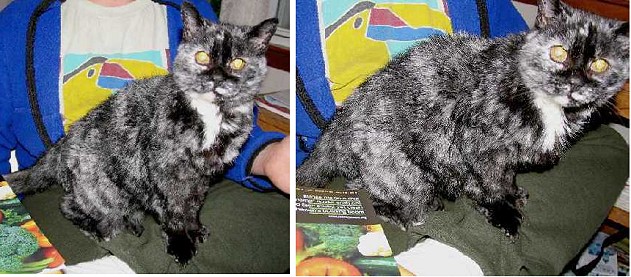
Pandora (owned by Bill B, Granby, MA, USA) is a brindled cat with what appears to be an unusual mutation. She has the brindled pattern typical of tortoiseshell cats, but the patches which should be red are white! Possibly 15 year old Pandora has a mutation that prevents her producing red pigment. An alternative explanation is that Pandora is chimera formed when a black embryo and a white embryo fused in the womb; however chimeras tend to have a patched appearance rather than being brindled, which makes chimerism unlikely. Perhaps the gene that should produce red pigment is faulty. Since Pandora was spayed before Bill obtained her, it isn't possible to breed her to see if it can be inherited. I have seen the opposite mutation - where a tortoiseshell cat produced red pigment, but not black, resulting in a red, cream and white brindled cat. The answer may lie in a recently discovered colour in cats known as "roan" or "tweed" where white hairs are evenly intermixed with coloured hairs. This shows up to best effect on black cats as it produces a salt-and-pepper effect.
THE "ALL-BLACK" SIAMESE CAT
Antiquarian accounts must always be taken with a pinch of salt since facts may be obscured by mythology. Thai literature speaks of an old Thai variety (i.e. old-type Siamese or European Burmese type) with black fur, black teeth, black eyes and black tongue. This creature was known to Thais as the "Ninlaret" (or black/dark sapphire/pearl) and is a candidate for cryptozoology or veterinary science rather than the modern showbench.
What is the likelihood of an "all-black cat"? The Chow dog breed has a purple tongue, which may appear blackish, so a feline "black-tongued" mutation is feasible. The human medical condition porphyria can cause teeth and nails to stain red or black-red and this would explain the Ninlaret's black teeth. It might conceivably cause dark red staining of the eyes, which would explain the Ninlaret's black eyes. Possibly the Thai Ninlaret cats were an inbred group of cats which had porphyria. Porphyria may also occur intermittently and is also associated with dementia ("The Madness of King George") and photosensitivity (intolerance of bright light); in humans it accounts for some reports of vampires.
The trait, if it is more than a folktale, has vanished and no such cats have been reported in recent times. As a cautionary note to would-be breeders of black-eyed, black-tongued, black-clawed, black-toothed cats, a debilitating medical condition such as porphyria is emphatically not a sound basis for a breed! Alternatively, it is an exaggerated account of a Siamese-type cat which did not have the gene which causes the colourpoint pattern; analogous to the Foreign (Oriental) Black. From later discussion with a traveller to Thailand, it turns out that "Black Pearl" is the name given to very dark grey/indigo Korats!
Not quite an all-black Siamese cat, but certainly worth of mention is the black-tongued black cat owned by Nickolas Heckman. This cat, which died in 2003, was black-furred and had black paw-pads, but golden eyes - so far quite unremarkable. She also had black-streaked teeth and a black tongue. She was adopted while Nickolas was living in Texas around 16 years ago. Being born to a barn cat, her exact origins are unknown, but the mother was a colourpoint cat that closely resembled a Siamese. This black-tongued feline had one litter of kittens, but none survived as she refused to care for them.
PINK CATS OF THAILAND
Old Thai writings are littered with strange coloured cats; for example the "Ratana Kampon", a pink cat with a band around its body. The description of "pink like the inside of a conch shell" corresponds to the "cameo" colour of red tipped and shaded Persians in the West. During the 1970s, "Pink Persians" (cameo Persians) were exhibited on the BBC's "Nationwide" programme. The Ratana Kampon was possibly a red shaded or red tipped Oriental. However, a more likely explanation of the Ratan Kampon is the presence of a gene known to modern breeders as the dilute modifier (or "caramelising" gene).
Some Oriental breeds carry dilute modifier genes which change a cream colour into a pinkish cream called "apricot". Oriental breeds are mainly derived from Thai cats and the apricot colour is very likely to have shown up in its native Thailand. In colourpointed (Siamese) cats, there would be a wide pale band around the body. The Ratana Kampon is probably a Foreign (Oriental) Apricot, Apricot Burmese (European style) or an Apricot Colourpoint. Modern apricot equivalents of the ancient Thai cats can be found on many showbenches where they are considered "new" varieties! When the first seal-point Siamese were exhibited in England, these were described as unnatural freaks!
A letter to "Our Cats" in October 1955 read: "PINK CATS. Are you able to tell me anything about " pink " cats ? On holiday recently in Italy. visiting Fiesole, we spoke to a white cat and noticed that his legs and fur had a decidedly pinkish tinge. We were amused at this but thought it may be attributed to something rubbed into his skin. However, later on, just near Assisi, we saw another cat which looked white, but on stroking him there was no doubt at all this time his face, legs and fur were pink." . . . Mrs. E. A. Glenny, Hanworth, Middlesex.
THE PINK CATS OF ENGLAND
In 2005, a 9 year old white cat called Brumas turned pink after going out for a walk near his home in Bratton Clovelly, Devon, England. His owners Philip and Joan Worth took Brumas to their vet in Launceston, Cornwall who diagnosed non-toxic dye on Brumasís coat. Brumas was bright pink on his head, ears and right down his body, but not underneath. The source of the colour wasnít known; sheep or cattle dye or paintball dye being likely suspects rather than paint as the catís fur was not matted.
In 2010 The owner of a pink cat got into trouble after she dyed her white cat cat, named Oi! Kitty, pink to match her hair. Natasha Gregory, from Swindon, carefully used non-toxic food colourant to turn the short-haired cat's fur a vivid shade of pink. When an unperturbed Oi! Kitty was seen in a neighbouring garden, it sparked an RSPCA investigation, with RSPCA officers believing it was a sick prank. Animal experts claimed that the reddish tint could provoke an adverse response in some other animals.
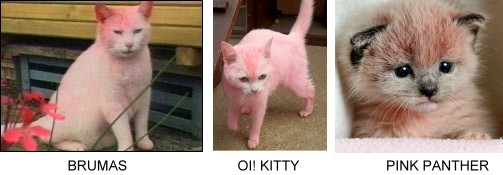
In 2011 four abandoned four-week old kittens were found at Ladds concrete factory in Redruth, Cornwall. When rescuers tried to wash the kittens they couldn't remove the reddish hue from one, earning her the nickname 'Pink Panther'. She lost her pink tint when her fur grew out over the next few months. The other kittens - Clouseau, Dusty and Cerise Ė had also come into contact with red pigment used in concrete manufacturing, but the dye showed up to best effect on Pink Pantherís creamy colour fur.
FELINE VITILIGO (LEUKODERMA, PIEBALDISM)
Leukoderma ("white skin"), leukotrichia ("white hair") or vitiligo, is a cosmetic condition that produces a "cobweb" or "snowflake" effect and is most easily seen on black cats. White spots appear on the coat; these become more extensive with age until the cat has a white lace pattern on the black fur. Ultimately the cat may go completely white or be left with diminishing isolated patches of colour. This condition has been seen in black leopards ("cobweb panthers"), humans, dogs and other animals. This must not be confused with the normal sprinkling of isolated white hairs which appear in a cat's fur during its lifetime. "Leukotrichia" is a generic term. Acommon term is "piebaldism" because it causes white patches in the skin and fur. It is an "aquired depigmentation" that occurs during the cat's lifetime, is usually progressive and may be triggered by illness or environmental factors. Ultimately, a cat with leukoderma may become almost entirely white. Antibodies are formed against the pigment-producing melanocytes. The melanocytes are destroyed leading to the white areas. A type of leukoderma has been identified in some Persian cats and these are used as laboratory subjects in the study of depigmentation conditions. Periocular leukotrichia, causes the fur around the cat's eyes to become pale - as though the cat is wearing spectacles.
|
| |
|
|
|
"Charva" (Jason Reeves) has vitiligo; she was a black cat with patches of slightly longer/softer black hair. In 2009 she turned 4 and developed a patch of white hair. Since then the patches of white have turned into stripes, spots, and patches. Her skin is turning pink as well due to the loss of pigmentation.
In 2011, Kimberly Sexton of New York City sent these photos of her cat Frankie. Kimberly's 14 year old cat Miko (white with grey markings on his head and tail) had recently died and in his last 3 years had formed a close bond with her younger cat, Frankie, a mackerel tabby. The two cats often slept intertwined. Two years before Miko passed away, Frankie developed a white spot of fur under his neck, while his chin and nose became paler. As time passed, Frankie's white areas spread and new ones developed around his neck and behind his shoulder blades. Kimberly joked to friends that Miko's white colour was rubbing off on Frankie as they slept! Frankie's white areas are likely to continue spreading, but the effect appears entirely cosmetic.
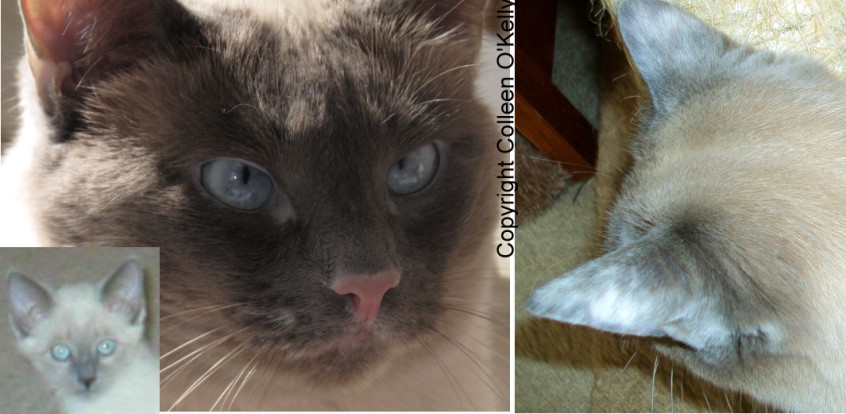
Vitiligo is not confined to black cats, but is harder to spot in lighter colour cats. Colleen O'Kelly, a physician in the USA, has a lilac-point Siames called Gracie tht has vitiligo. Her point colour was normal as a kitten, but over time her ears have become cobwebbed with white and her muzzle is now showing a similar lightening. Most strikingly, her nose has lost its dark pigmentation and her whiskers on one side have turned white.
MORE ANOMALIES
If you have come to this page directly from a search engine, please check out
FELINE MEDICAL CURIOSITIES for the full index of topics includingBOOKS ABOUT ANOMALIES
If you are interested in medical curiosities, books worth reading are "Mutants: on the Form, Varieties and Errors of the Human Body" by Armand Marie Leroi and "Anomalies and Curiosities of Medicine Vols 1 and 2" by George M. Gould & Walter L. Pyle. The Gould & Pyle books were published in 1896 and are in the public domain. You can download text-only versions of Gould & Pyle from several websites so don't waste money on text-only versions of the book; but if you want the versions with photos, consider the Kessinger editions. The Leroi book explains why and how some deformities and anomalies happen - the mechanism is the same in cats as it is in humans.
You are visitor number